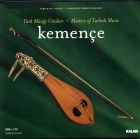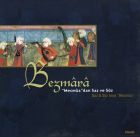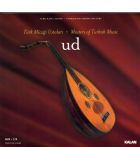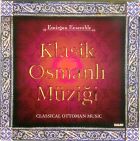Buy or gift a stand-alone digital subscription and get unlimited access to dozens of back issues for just £18.99 / $18.99 a year.
Please register at www.exacteditions.com/digital/cornucopia with your subscriber account number or contact subscriptions@cornucopia.net
Buy a digital subscription Go to the Digital EditionThanks to the musicologist and luthier Fikret Karakaya, our 21st-century ears can now enjoy the long-lost sounds of early Ottoman music. His quest to revive these authentic sounds has been lengthy and painstaking – not least because he had to reinvent the instruments, then learn to play them. By Caterina Scaramelli. Photographs by Fritz von der Schulenburg
Buzzing sounds and a smell of warm glue filter through the grey metal door of the luthier’s workshop and down a narrow Göztepe side street. My nostrils full of wood dust, I follow Faruk Türünz, a scientist of lutherie, from one room to the other as he guides me through the secrets of his craft – the physics of acoustics. The strangely shaped tools of his trade hang in orderly ranks on the walls, standing guard over skeletons of dismembered musical instruments. Five men are absorbed in their delicate work.
Fikret Karakaya – kemençe performer, philosopher, encyclopaedist, musicologist, historian and, above all, luthier and organologist – worked here alongside Faruk Bey for nearly a decade before moving to smaller, quieter premises. There, in a studio bursting at the seams with old books, instruments and records, Fikret Bey recounts how he came to realise his dream of playing Ottoman music of the 16th to the 18th centuries on immaculate reconstructions of the original instruments. And a great and arduous enterprise it was, for not only were these instruments constantly changing – falling out of fashion, then regaining popularity – but no original instruments from before the 18th century have survived to the present day.
Today, listening to a recording by the Bezmârâ Ensemble of a 17th-century fasıl concert, I hear these instruments, lost to the world for so long and now reborn. My ear wanders from the sound of a plucked lute to that of an unfamiliar string. Over it all, the ney blows softly yet at times piercingly, while a deeper lute is plucked an octave lower. The pattern of these makams is ethereal and worldly, both grave and witty at the same time.
The Bezmârâ project was born in 1995. At the time Fikret Karakaya was writing a book on musical instruments of the world and performing on the kemençe, a small pear-shaped instrument played vertically with a bow, for TRT Radio. His initial idea was to produce a record of music from the collection of Dimitrie Cantemir, a fascinating historical figure. This Moldavian prince, the son of the voyvoda (governor) of Moldavia, had been sent to Istanbul as a hostage to guarantee his father’s loyalty and lived there between 1687 and 1710. Kantemiroğlu, as he is known in Turkey, was an intellectual – a historian, an accomplished tanbur player and composer – as well as a witty politician. Before escaping to Russia after a failed attempt to gain Moldavia’s independence via a secret pact with the Tsar, Cantemir devised a letter-based notation system to write down a collection of 352 instrumental Ottoman pieces – 315 peşrev and 37 semâi – and an accompanying theoretical treatise.
Fikret’s project, under the patronage of the French Institute of Anatolian Studies in Istanbul, soon grew beyond Cantemir’s collection. Why not reconstruct the lost instruments and train musicians to play them again? Fikret had been playing the kemençe since his years at Istanbul’s Academy of Fine Arts and later at the University’s faculty of philosophy. Now he learnt how to build it, thanks to his luthier friends in Göztepe.
The Ottoman musical world was an extremely lively one. Music permeated all strata of society and travelled over long distances. Developments in instrumentation followed changing cultural and political influences, wars and migratory flows. The Topkapı Palace was a centre of musical teaching and performance, with a room dedicated to musical instruction. Slave musicians performed in concert ensembles, as did professional ones who were on the payroll. Women played the çeng or, later, the kanun. Mevlevi convents provided further centres of music: Mevlevi dervishes developed an instrumental tradition and entered and influenced the courtly ensemble, especially at the end of the 18th century. Mehter military music was yet another discipline. Many aristocrats and intellectuals – even sultans – were skilled amateur musicians. The secular and the religious, the grand and the popular – all played a part.
At the end of the 17th century a unique Turkish Ottoman musical tradition emerged: modulations between different makam (modes) became frequent; taksim (improvisations) grew longer and freer, coming to constitute a genre in their own right; and fasıl (instrumental) concerts took new forms. Instruments that in Persia merely accompanied the voice became the protagonists in purely instrumental compositions, peşrevs and semâî. These changes in the social life of instruments hint at the scope and complexity of the Bezmârâ project.
The Ottoman–Safavid wars, beginning in the 16th century, had brought Ottoman music into closer contact with that of the Persian world. Scores of Acem (Persian) musicians played at the palace. But by the 17th century a new style surfaced and many Persian instruments left the scene. The delicate mıskâl (a pan flute) disappeared. The mystical, wailing ney, a wind instrument, was no longer played by the Acem musicians and changed its shape: by the 18th century it was the star of the Ottoman orchestra. The sensuous and difficult-to-master çeng, with its joyful but timid sound, an instrument played by both men and women, fell into oblivion, along with the trapezoidal plucked kanun, which would reappear in a new form in the 18th century. Its old cousin, the hammered santur (dulcimer), an instrument with Iranian roots, joined the 17th-century ensemble, but by the mid-19th century had retreated, its tuning unable to accommodate the micro-intervals of Turkish music. Today’s Iranian santurs are very different from the Ottoman ones, of which none survive from before the 19th century.
The kopuz, a lute half-covered in leather, and the ud (barbat in Persian), a large-bodied short-necked lute played with a plectrum, proudly dominated the 16th-century courtly ensemble, their masters receiving the highest salaries in the palace. The ud remained the most popular courtly instrument until the 17th century, when it fell from favour and disappeared. Both kopuz and ud were overtaken by the six-stringed tanbur, an ancient fretted lute, different versions of which exist in Anatolia, and, eventually, by the guitar. The ud did not return until the early 20th century, via Syria and Egypt. A larger, big-bellied lute, the şehrûd, appeared frequently in 16th-century miniatures, virtually hiding the player behind its large body. Tuned an octave below, it gave depth to the songs it accompanied. But by the 18th century the Ottoman orchestra starred the tanbur, ney, kemânçe (spike fiddle or rebab) and santur.
The 19th century saw tumultuous changes in both music and instruments. Musicians poured into Istanbul from all over the Balkans, bringing with them faster, more virtuosic styles. The Greek stringed lyra politikas (the “lyre of Constantinople”), now known as the kemençe (Mevlevis call it rebab) – and not to be confused with the kemânçe (spike fiddle) – left the restaurants and taverns to join the fasıl ensemble, thanks to the skill of the great semâi player Cemil Bey. The sentimental viola d’amore from Europe superseded the long-necked kemânçe, and the guitar joined in. At the same time, a genre known as kanto, with its ear-grabbing songs based on makams but accompanied by Western instruments, gradually won over the popular sphere and the newborn record industry.
Fikret Karakaya’s quest to trace the life stories of the instruments and so to give authentic voice to the Ottoman repertoire of different historical periods was a complex one, for there are few sources on 18th-century music. But an even harder task was building the instruments anew. Extensive knowledge of lutherie and world musical instruments was essential, says Fikret Bey, for to reconstruct old instruments is, in effect, to reinvent them: “It was necessary to use imagination.”
Painstaking research was essential, into Turkish, Persian, Uzbek and Indian miniatures and primary written sources. Among these was the collection of Kantemiroğlu in the Kitâbu İlmi’l- Musiki ‘alâ Vechi’l-Hurûfât (The Book for Teaching Music by Means of Letters) performed on Bezmârâ’s first album.
Fifty years previously, another colourful historical figure, the Pole Wojciech Bobowski, who was captured in his youth and taken to Istanbul as a music slave, had left another collection, the Mecmûa-i Sâz ü Söz (Collection of Instrumental and Vocal Works), which he wrote under the name Ali Ufkî, using Western musical notation but read from right to left. Ali Ufkî, like Kantemiroğlu, was a polyglot. A dragoman and an intellectual, he gained his freedom and became a key player at the palace.
Back in the 20th century, Fikret Bey makes sketches of hypothetical instruments such as the çeng, kopuz, şehrûd, tanbur, ud, kanun, kemânçe and mıskâl and discusses them with Walter Feldman, an American ethnomusicologist who specialises in the Ottoman and Central Asian worlds. Many design choices require technical bravery and intuition: should the soundboard be flat or curved, for example, and should the shape be square or rounded?
Today Fikret Karakaya and Faruk Türünz, the musical historian, are working in Faruk Bey’s workshop. Here the instruments are skilfully crafted, and their crystalline sounds resonate. Faruk Bey, who has studied political science and architecture and is a self-taught physical scientist, “listens” to the vibrations of wood with an electronic tool and converts the readings into measurements using equations on Excel. His collaborator, Suat Çetincan, is the mind behind the mysterious electric tools adorning the workshop’s walls, invented to impose perfection on capricious wood.
Once the instruments have been built, someone must learn to play them. Fikret Bey’s specially recruited classical musicians soon adapted to the strange proportions of the instruments and to the old techniques. He himself has mastered the çeng, the first old instrument he built. As he plays his favourite makam, his studio seems to expand, filled with centuries of vibrations.
At last early Ottoman music has come back to life and started to breathe again.
Bezmârâ Ensemble have performed early Ottoman music all over the world and are giving monthly recitals in Istanbul in 2010 as part of the European Capital of Culture programme, which has declared 2010 Ali Ufkî Year. Their recordings include ‘Splendour of Topkapı’ (Opus 111, 1999), ‘Yitik Sesin Peşinde’ (In Search of the Lost Sound) (Kalan, 2000) and ‘Mecmûa’dan Saz ve Söz’ (Music and Songs from Ufkî Bey’s Collection) (Kalan, 2004). Fikret Karakaya recently released an album featuring his own compositions, entitled’ Eski Muskinin Rüzgârıyla’ (On the Breeze of Old Music) (Güvercin, 2009).
Famous for his atmospheric films set in stark landscapes, Nuri Bilge Ceylan is now attracting attention with his photography. Maureen Freely leafs through the pages of a fine limited-edition album of his enigmatic, painterly scenes
In September 2009, six travellers set out on horseback to retrace the early part of the route taken in 1671 by the Ottoman traveller Evliya Çelebi on his way to Mecca.
Spirited impressions of Ottoman Istanbul in the 16th century from a mischievous Danish artist and an acerbic Flemish envoy.
When eaten raw as a salad, turnips are shredded or thinly sliced like radishes. Their distinctive mustardy bite, which cleanses the palate, makes them excellent company for rich meats and fish. Cooking however, transforms the starch in the turnip, giving it a mellow taste.
More cookery features
The Great Mosque and Hospital of Divriği, an imperilled masterpiece of Islamic art in the remote upper Euphrates, is the only single building in Turkey given world heritage status. Cornucopia celebrates this medieval marvel with a 26-page guide to its mad, exuberant architecture through the stunning photographs of Cemal Emden
The city of Dresden is now home to one of the finest displays of Turkish art and armoury
Little known and rarely visited, the hauntingly beautiful sanctuary of Zeus at Labraunda – built by the family of the legendary Mausolus high above Milas – was for centuries Aegean Turkey’s most revered shrine. A Swedish team has managed to uncover the ruins without sacrificing the serenity of these sacred hills.
Daniel Shaffer explains the value of the Great Mosque of Divriği’s ancient carpets.
Reassuringly inaccessible, Divriği has always taken time to reach – and its riches time to savour. Patricia Daunt on the historical figures who made the journey


Bezmärä Ensemble


The Emirğan Ensemble

Cornucopia works in partnership with the digital publishing platform Exact Editions to offer individual and institutional subscribers unlimited access to a searchable archive of fascinating back issues and every newly published issue. The digital edition of Cornucopia is available cross-platform on web, iOS and Android and offers a comprehensive search function, allowing the title’s cultural content to be delved into at the touch of a button.
Digital Subscription: £18.99 / $18.99 (1 year)
Subscribe now